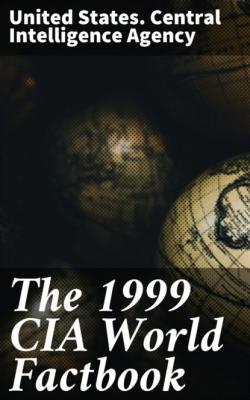The 1999 CIA World Factbook. United States. Central Intelligence Agency
Чтение книги онлайн.
Читать онлайн книгу The 1999 CIA World Factbook - United States. Central Intelligence Agency страница 25
 of the Congo 2,511 km of which
of the Congo 2,511 km of which220 km is the boundary of discontiguous Cabinda Province, Republic
of the Congo 201 km, Namibia 1,376 km, Zambia 1,110 km
Coastline: 1,600 km
Maritime claims:
exclusive economic zone: 200 nm
territorial sea: 12 nm
Climate: semiarid in south and along coast to Luanda; north has
cool, dry season (May to October) and hot, rainy season (November to
April)
Terrain: narrow coastal plain rises abruptly to vast interior
plateau
Elevation extremes:
lowest point: Atlantic Ocean 0 m
highest point: Morro de Moco 2,620 m
Natural resources: petroleum, diamonds, iron ore, phosphates,
copper, feldspar, gold, bauxite, uranium
Land use:
arable land: 2%
permanent crops: 0%
permanent pastures: 23%
forests and woodland: 43%
other: 32% (1993 est.)
Irrigated land: 750 sq km (1993 est.)
Natural hazards: locally heavy rainfall causes periodic flooding on the plateau
Environment—current issues: the overuse of pastures and subsequent soil erosion attributable to population pressures; desertification; deforestation of tropical rain forest, in response to both international demand for tropical timber and to domestic use as fuel, resulting in loss of biodiversity; soil erosion contributing to water pollution and siltation of rivers and dams; inadequate supplies of potable water
Environment—international agreements: party to: Biodiversity, Desertification, Law of the Sea signed, but not ratified: Climate Change
Geography—note: Cabinda is separated from rest of country by the
Democratic Republic of the Congo
People
Population: 11,177,537 (July 1999 est.)
Age structure:
0–14 years: 45% (male 2,545,006; female 2,473,732)
15–64 years: 52% (male 2,938,178; female 2,909,844)
65 years and over: 3% (male 143,074; female 167,703) (1999 est.)
Population growth rate: 2.84% (1999 est.)
Birth rate: 43.11 births/1,000 population (1999 est.)
Death rate: 16.35 deaths/1,000 population (1999 est.)
Net migration rate: 1.6 migrant(s)/1,000 population (1999 est.)
Sex ratio:
at birth: 1.05 male(s)/female
under 15 years: 1.03 male(s)/female
15–64 years: 1.01 male(s)/female
65 years and over: 0.85 male(s)/female
total population: 1.01 male(s)/female (1999 est.)
Infant mortality rate: 129.19 deaths/1,000 live births (1999 est.)
Life expectancy at birth: total population: 48.39 years male: 46.08 years female: 50.82 years (1999 est.)
Total fertility rate: 6.12 children born/woman (1999 est.)
Nationality: noun: Angolan(s) adjective: Angolan
Ethnic groups: Ovimbundu 37%, Kimbundu 25%, Bakongo 13%, mestico
(mixed European and Native African) 2%, European 1%, other 22%
Religions: indigenous beliefs 47%, Roman Catholic 38%, Protestant
15% (1998 est.)
Languages: Portuguese (official), Bantu and other African
languages
Literacy:
definition: age 15 and over can read and write
total population: 42%
male: 56%
female: 28% (1998 est.)
Government
Country name:
conventional long form: Republic of Angola
conventional short form: Angola
local long form: Republica de Angola
local short form: Angola
former: People's Republic of Angola
Data code: AO
Government type: transitional government, nominally a multiparty democracy with a strong presidential system
Capital: Luanda
Administrative divisions: 18 provinces (provincias,
singular—provincia); Bengo, Benguela, Bie, Cabinda, Cuando Cubango,
Cuanza Norte, Cuanza Sul, Cunene, Huambo, Huila, Luanda, Lunda
Norte, Lunda Sul, Malanje, Moxico, Namibe, Uige, Zaire
Independence: 11 November 1975 (from Portugal)
National holiday: Independence Day, 11 November (1975)
Constitution: 11 November 1975; revised 7 January 1978, 11 August 1980, 6 March 1991, and 26 August 1992
Legal system: based on Portuguese civil law system and customary law; recently modified to accommodate political pluralism and increased use of free markets
Suffrage: 18 years of age; universal
Executive branch:
chief of state: President Jose Eduardo DOS SANTOS (since 21
September 1979); note—the president is both chief of state and head
of government
head of government: President Jose Eduardo DOS SANTOS (since January
1999); note—the president is both chief of state and head of